Effectiveness of the Concrete Equivalent Mortar Method for the Prediction of Fresh and Hardened Properties of Concrete
Abstract
:1. Introduction
2. Materials and Methods
2.1. Raw Materials
2.2. Mix Design Method
2.3. Experimental Tests
3. Results
3.1. Basic Mechanical Properties
3.2. Post-Cracking Behaviour
3.3. Analytical Modeling of Flexural Behaviour
- -
- Linear elastic (Phase 0),
- -
- Cracked with softening behaviour (Phases I, II, and III),
- -
- Cracked without stress transfer between the crack lips (Phase IV).
3.4. Results of the Inverse Analysis
4. Conclusions
Author Contributions
Funding
Data Availability Statement
Conflicts of Interest
References
- Louro, A.S. Concrete Structures; Springer: Cham, Switzerland, 2021. [Google Scholar]
- Aïtcin, P.-C. High-Performance Concrete; CRC Press: Boca Raton, FL, USA, 2019. [Google Scholar]
- Wang, D.; Shi, C.; Wu, Z.; Xiao, J.; Huang, Z.; Fang, Z. A review on ultra-high-performance concrete: Part II. Hydration, microstructure and properties. Constr. Build. Mater. 2015, 96, 368–377. [Google Scholar] [CrossRef]
- Rahmani, F.; Paterno, D.; Gharehbaghi, S. Performance of FRC and GPC for High-Rise Construction: Case Studies. IOP Conf. Series Mater. Sci. Eng. 2020, 829, 12002. [Google Scholar] [CrossRef]
- Bertola, N.; Schiltz, P.; Denarié, E.; Brühwiler, E. A Review of the Use of UHPFRC in Bridge Rehabilitation and New Construction in Switzerland. Front. Built. Environ. 2021, 7, 769686. [Google Scholar] [CrossRef]
- Gastaldi, D.; Bertola, F.; Irico, S.; Paul, G.; Canonico, F. Hydration behaviour of cement with reduced clinker factor in mixture with sulfoaluminate binder. Cem. Concr. Res. 2021, 139, 106261. [Google Scholar] [CrossRef]
- More, F.M.; Subramanian, S.S. Impact of Fibres on the Mechanical and Durable Behaviour of Fibre-Reinforced Concrete. Buildings 2022, 12, 1436. [Google Scholar] [CrossRef]
- Shi, J. Fibre-Reinforced Polymers and Fibre-Reinforced Concrete in Civil Engineering. Buildings 2023, 13, 1755. [Google Scholar] [CrossRef]
- Farinha, C.B.; de Brito, J.; Veiga, R. Incorporation of high contents of textile, acrylic and glass waste fibres in cement-based mortars. Influence on mortars’ fresh, mechanical and deformability behaviour. Constr. Build. Mater. 2021, 303, 124424. [Google Scholar] [CrossRef]
- Hannawi, K.; Bian, H.; Prince-Agbodjan, W.; Raghavan, B. Effect of different types of fibers on the microstructure and the mechanical behavior of Ultra-High Performance Fiber-Reinforced Concretes. Compos. Part B Eng. 2016, 86, 214–220. [Google Scholar] [CrossRef]
- Kaikea, A.; Achoura, D.; Duplan, F.; Rizzuti, L. Effect of mineral admixtures and steel fibre volume contents on the behaviour of high performance fibre reinforced concrete. Mater. Des. 2014, 63, 493–499. [Google Scholar] [CrossRef]
- Bellum, R.R. Influence of steel and PP fibres on mechanical and microstructural properties of fly ash-GGBFS based geopolymer composites. Ceram. Int. 2021, 48, 6808–6818. [Google Scholar] [CrossRef]
- Buratti, N.; Mazzotti, C.; Savoia, M. Post-cracking behaviour of steel and macro-synthetic fibre-reinforced concrete. Constr. Build. Mater. 2011, 25, 2713–2722. [Google Scholar] [CrossRef]
- Kazmi, S.M.S.; Munir, M.J.; Wu, Y.-F.; Patnaikuni, I. Effect of macro-synthetic fibres on the fracture energy and mechanical behaviour of recycled aggregate concrete. Constr. Build. Mater. 2018, 189, 857–868. [Google Scholar] [CrossRef]
- Pourbaba, M.; Chakraborty, R.; Pourbaba, M.; Belarbi, A.; Yeon, J.H. A New Insight into the Design Compressive Strength of Ultra-High Performance Concrete. Buildings 2023, 13, 2909. [Google Scholar] [CrossRef]
- Setra Service D’études Techniques des Routes et Autoroutes, Association Française de Génie Civil. Documents Scientifiques et Techniques Bétons Fibrés à Ultra-Hautes Performances Ultra High Performance Fibre-Reinforced Concrètes. Recommandations provisoires, Interim Recommendations; Association Française de Génie Civil: Paris, France, 2002. [Google Scholar]
- EN 206-1; Concrete (Specctn, performance, product, and conformity). European Standard Norms on Concrete. European Standards Organization: Brussels, Belgium, 2002.
- Akca, K.R.; Ipek, M. Effect of different fibre combinations and optimisation of an ultra-high performance concrete (UHPC) mix applicable in structural elements. Constr. Build. Mater. 2022, 315, 125777. [Google Scholar] [CrossRef]
- Fang, Z.; Luo, Y.; Chen, H.; Gao, Y.; Yang, W.; Wang, C. Research on mechanical properties and hydration characteristics of ultra-high performance concrete with high-volume fly ash microsphere. J. Build. Eng. 2023, 78, 107738. [Google Scholar] [CrossRef]
- Golewski, G.L. Measurement of fracture mechanics parameters of concrete containing fly ash thanks to use of Digital Image Correlation (DIC) method. Measurement 2019, 135, 96–105. [Google Scholar] [CrossRef]
- Golewski, G.L. Effect of curing time on the fracture toughness of fly ash concrete composites. Compos. Struct. 2018, 185, 105–112. [Google Scholar] [CrossRef]
- Buragohain, P.; Sreedeep, S.; Lin, P.; Garg, A. Investigation of fly ash for sorption of copper ions in multiple contaminant system: An implication on re-use of waste material under concept of sponge city. Measurement 2018, 124, 522–528. [Google Scholar] [CrossRef]
- Win, T.T.; Wattanapornprom, R.; Prasittisopin, L.; Pansuk, W.; Pheinsusom, P. Investigation of Fineness and Calcium-Oxide Content in Fly Ash from ASEAN Region on Properties and Durability of Cement–Fly Ash System. Eng. J. 2022, 26, 77–90. [Google Scholar] [CrossRef]
- Win, T.T.; Panwisawas, C.; Jongvivatsakul, P.; Pansuk, W.; Prasittisopin, L. Effects of Fly Ash Composition to Mitigate Conversion of Calcium Aluminate Cement Composites. Buildings 2023, 13, 2453. [Google Scholar] [CrossRef]
- Golewski, G.L. Effect of fly ash addition on the fracture toughness of plain concrete at third model of fracture. J. Civ. Eng. Manag. 2017, 23, 613–620. [Google Scholar] [CrossRef]
- Scopus Record. Paper’s on Cement-Based Composite Materials Reinforced with Fibre Polymer; Elsevier: Amsterdam, The Netherlands, 2023. [Google Scholar]
- Górszczyk, J.; Malicki, K.; Zych, T. Application of digital image correlation (DIC) method for road material testing. Materials 2019, 12, 2349. [Google Scholar] [CrossRef] [PubMed]
- Dai, S.; Liu, X.; Nawnit, K. Experimental Study on the Fracture Process Zone Characteristics in Concrete Utilizing DIC and AE Methods. Appl. Sci. 2019, 9, 1346. [Google Scholar] [CrossRef]
- Schwartzentruber, A.; Catherine, C. La méthode du mortier de béton équivalent (MBE)—Un nouvel outil d’aide à la formulation des bétons adjuvantés. Mater. Struct. 2000, 33, 475–482. [Google Scholar] [CrossRef]
- Assaad, J.J.; Harb, J.; Khayat, K.H. Use of Triaxial Compression Test on Mortars to Evaluate Formwork Pressure of Self-Consolidating Concrete View project 3D Concrete Printing View Project. 2009. Available online: https://www.researchgate.net/publication/297452138 (accessed on 12 December 2023).
- NF EN 934-2; European Standard on Admixture for Concrete, Mortar, and Grout. European Standards Organization: Brussels, Belgium, 2012.
- BS EN 933-1; Determination of Particle Size Distribution (Modified) Nominal Size of Aggregate 40 mm or Greater. British Standards Institution: London, UK, 1996.
- NF EN 1097-6; Tests for Mechanical and Physical Properties of Aggregates—Part 6. European Standards Organization: Brussels, Belgium, 2022.
- Omary, S.; Ghorbel, E.; Wardeh, G. Relationships between recycled concrete aggregates characteristics and recycled aggregates concretes properties. Constr. Build. Mater. 2016, 108, 163–174. [Google Scholar] [CrossRef]
- NF EN 12350-2; Testing Fresh Concrete—Part 2: Slump Test. European Standards Organization: Brussels, Belgium, 2019.
- NF EN 12390-13; Secant Modulus of Elasticity, Report. European Standards Organization: Brussels, Belgium, 2021.
- Gougelet, P. XnView MP Windows. 2021. Available online: https://www.xnview.com/en/xnviewmp/ (accessed on 14 April 2022).
- Ulfkjrer, J.P.; Brincker, R. Fracture energy of normal strength concrete, high strength concrete and ultra-strength -ultra ductile steel fibre reinforced concrete. J. Eng. Mech. 1995, 121, 7–15. [Google Scholar]
- Bakleh, B.; Hasan, H.; Wardeh, G. Analytical Model for the Prediction of Instantaneous and Long-Term Behaviour of RC Beams under Static Sustained Service Loads. Appl. Mech. 2023, 4, 31–43. [Google Scholar] [CrossRef]
- CEB-FIP, Model Code, (1990). fib Bulletin 65: Model Code 2010, Final draft—Volume 1, Bullatin 65. Available online: https://www.fib-international.org/publications/fib-bulletins/model-code-2010-final-draft,-volume-1-detail.html (accessed on 12 December 2023).



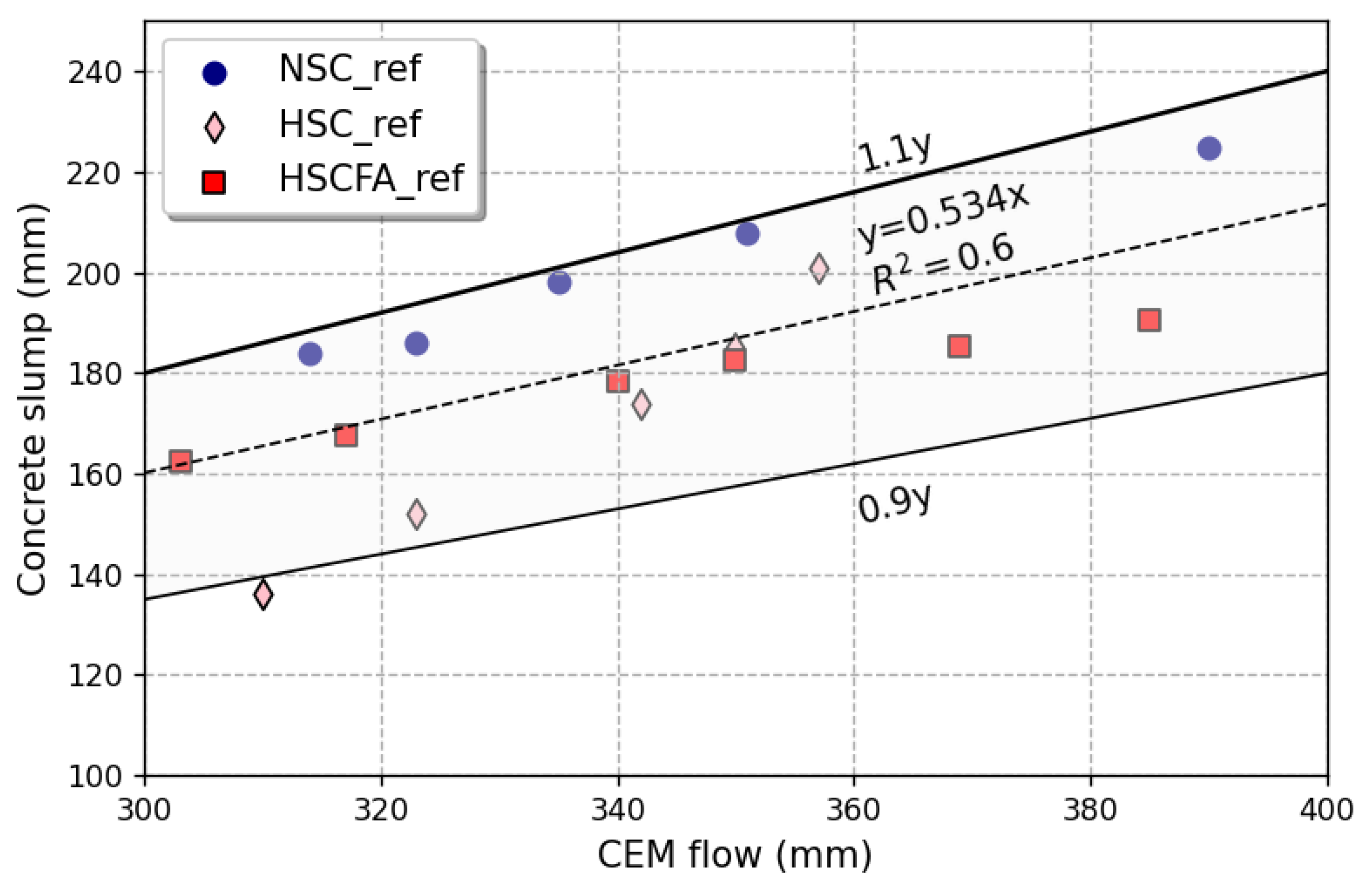
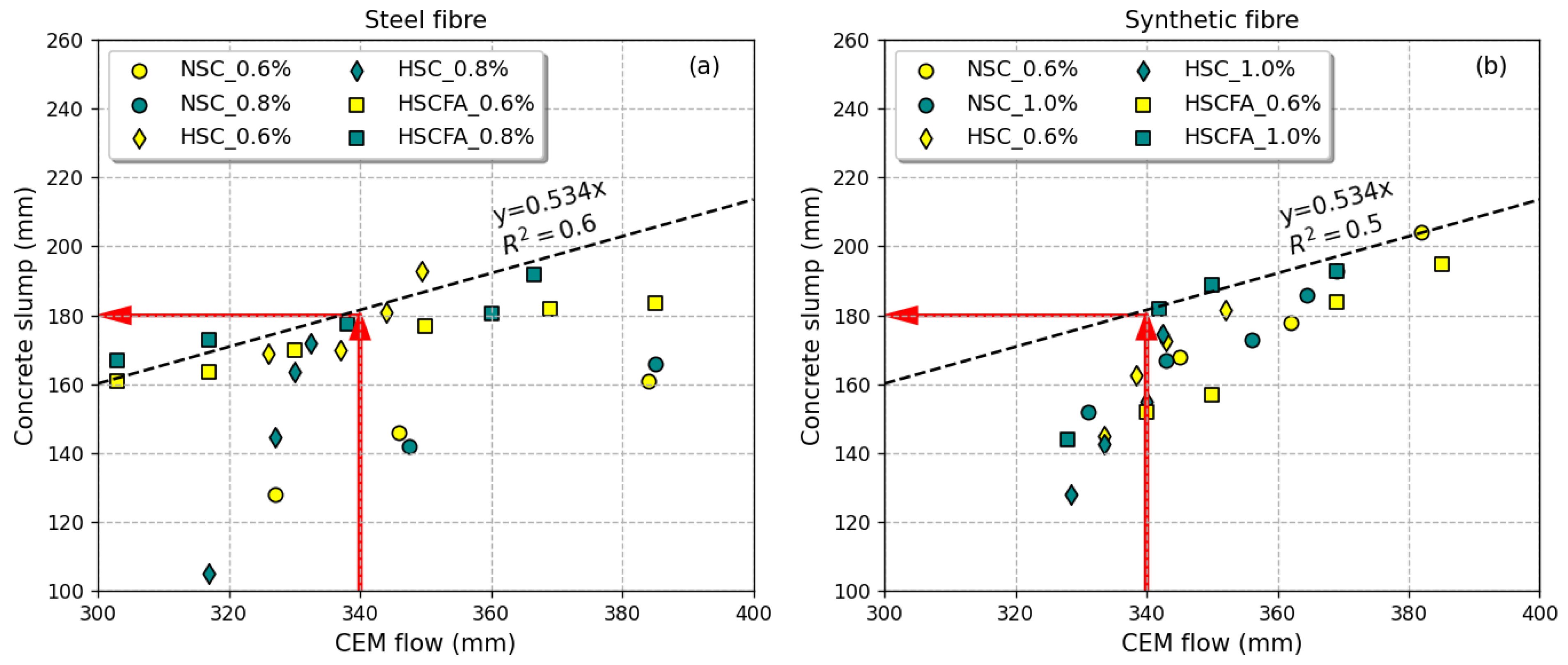


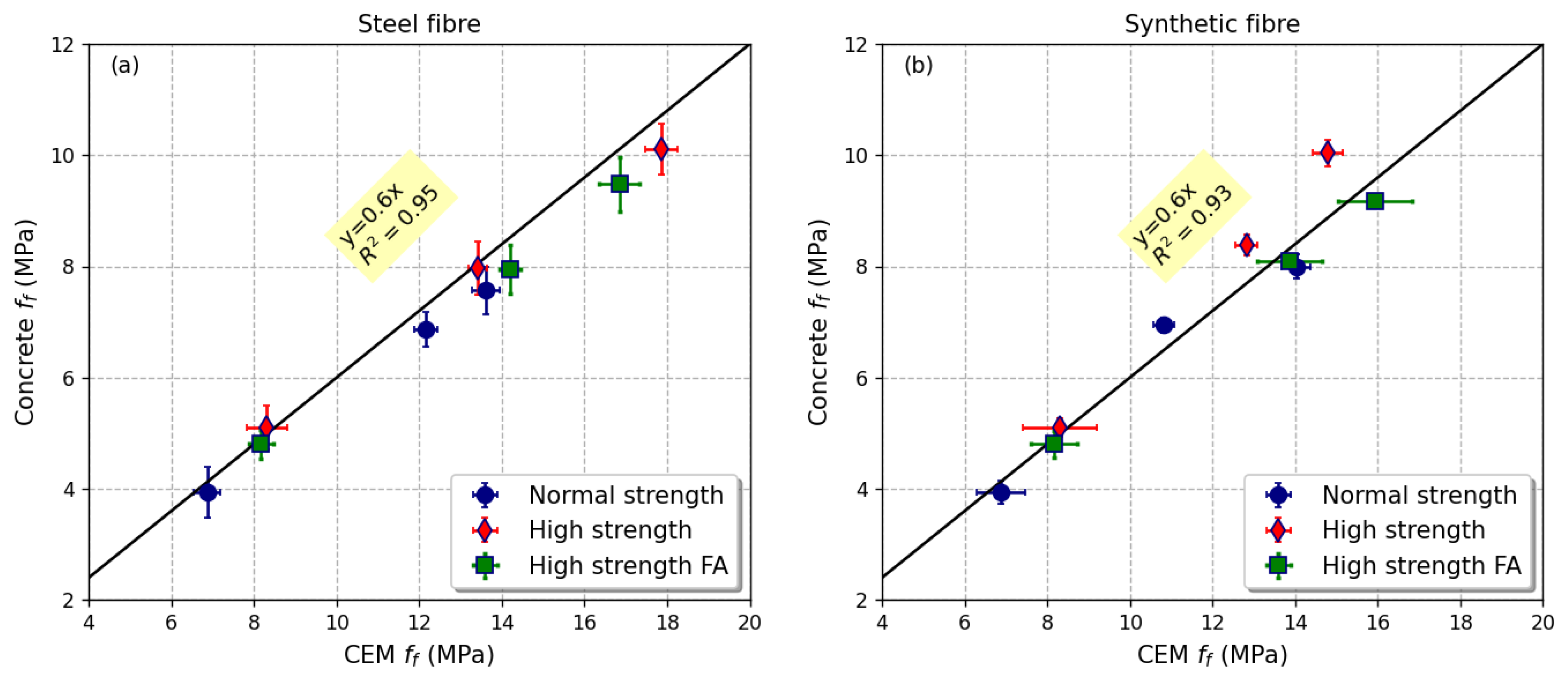


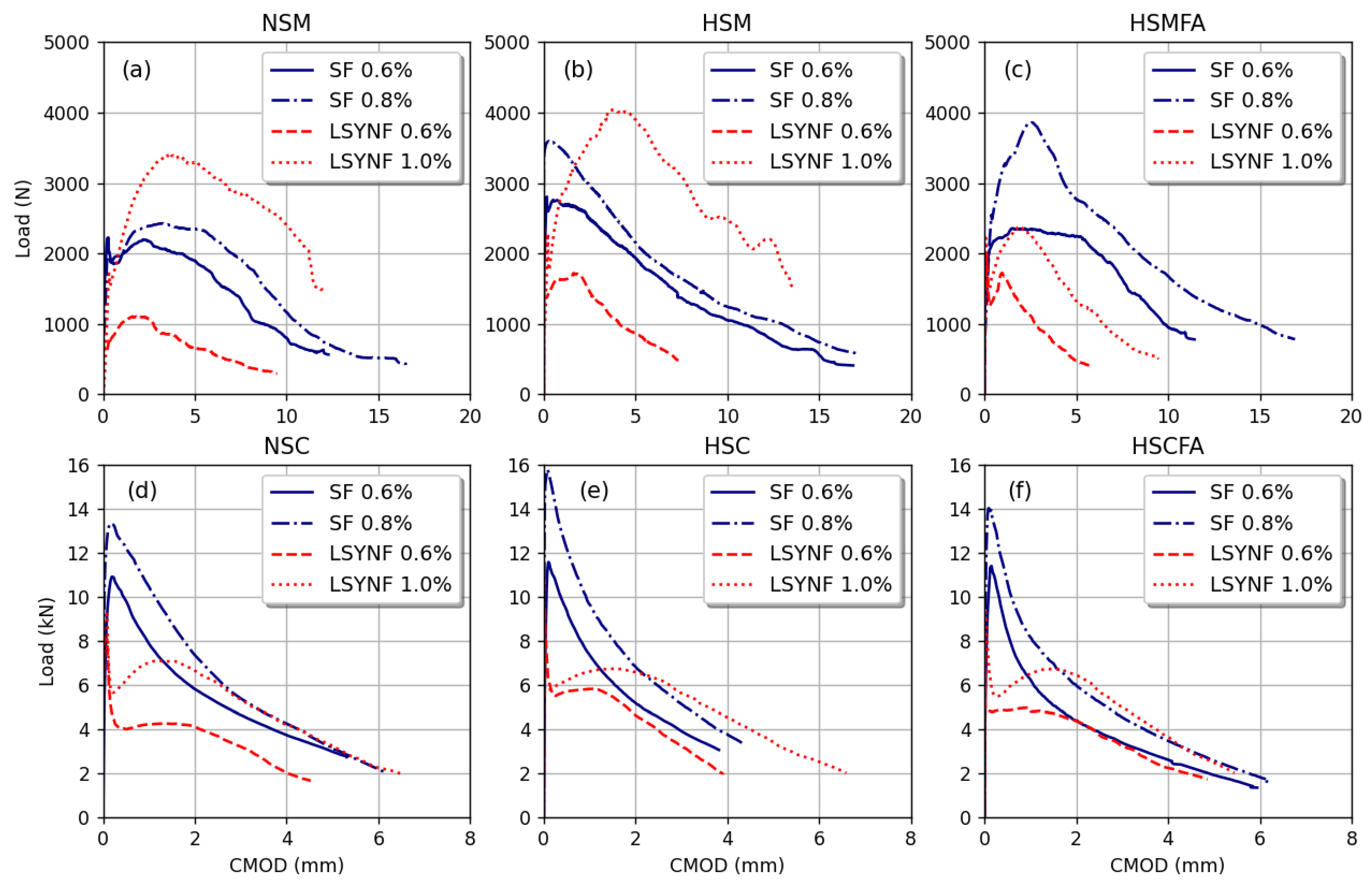

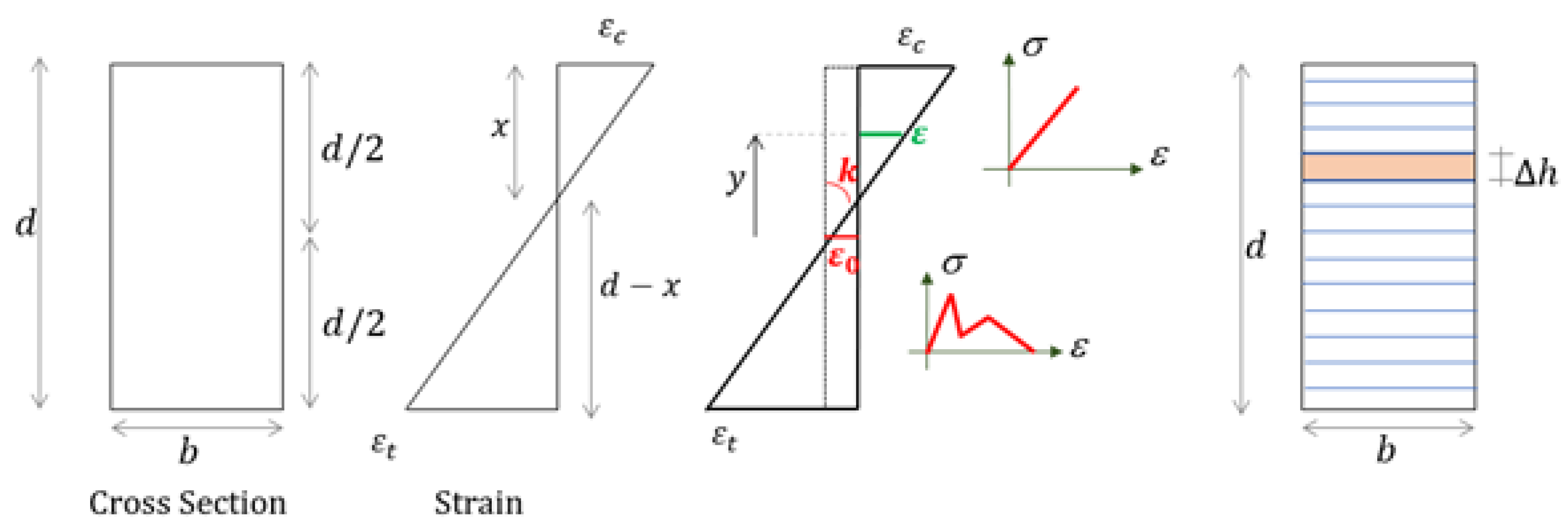


| Density ρrd | Water Absorption WA24 (%) | Fineness Modulus | Los Angeles (%) [34] | |
|---|---|---|---|---|
| Sand 0–4 mm | 2.55 | 1.14 | 2.82 | - |
| Gravel 4–10 mm | 2.70 | 0.67 | - | 17.5 |
| Mortars Identification | Cement (kg/m3) | Fly Ash (kg/m3) | Water (kg/m3) | Sand (kg/m3) | Fibre (kg/m3) | Superplasticiser (kg/m3) | ||
|---|---|---|---|---|---|---|---|---|
| NSM | Reference | NSM_ref | 577 | - | 289 | 1251 | - | 4.4 |
| Steel fibres | NSM_SF_0.6% | 576 | - | 288 | 1237 | 45 | 4.9 | |
| NSM_SF_0.8% | 575 | - | 288 | 1235 | 61 | 4.9 | ||
| Polypropylene fibres | NSM_LSYNF_0.6% | 578 | - | 288 | 1236 | 6 | 4.6 | |
| NSM_LSYNF_1.0% | 576 | - | 288 | 1230 | 9 | 4.6 | ||
| HSM | Reference | HSM_ref | 757 | - | 227 | 1208 | - | 27.2 |
| Steel fibres | HSM_SF_0.6% | 737 | - | 221 | 1172 | 45 | 35 | |
| HSM_SF_0.8% | 731 | - | 219 | 1159 | 66 | 49 | ||
| Polypropylene fibres | HSM_LSYNF_0.6% | 753 | - | 226 | 1159 | 6 | 28 | |
| HSM_LSYNF_1.0% | 750 | - | 225 | 1151 | 9 | 32 | ||
| HSMFA | Reference | HSMFA_ref | 701 | 73 | 233 | 1131 | - | 35 |
| Steel fibres | HSMFA_SF_0.6% | 700 | 74 | 233 | 1127 | 44 | 35 | |
| HSMFA_SF_0.8% | 694 | 73 | 231 | 1099 | 66 | 49 | ||
| Polypropylene fibres | HSMFA_LSYNF_0.6% | 710 | 76 | 206 | 1180 | 6 | 28 | |
| HSMFA_LSYNF_1.0% | 708 | 75 | 206 | 1175 | 9 | 32 | ||
| Concrete Identification | Cement (kg/m3) | Fly Ash (kg/m3) | Water (kg/m3) | Sand (kg/m3) | Gravel (kg/m3) | Fibre (kg/m3) | Superplasticiser (kg/m3) | ||
|---|---|---|---|---|---|---|---|---|---|
| NSC | Reference | NSC_ref | 380 | - | 190 | 763 | 991 | - | 2.9 |
| Steel fibres | NSC_SF_0.6% | 380 | - | 190 | 758 | 985 | 30 | 3.4 | |
| NSC_SF_0.8% | 380 | - | 190 | 759 | 983 | 45 | 3.4 | ||
| Polypropylene fibres | NSC_LSYNF_0.6% | 380 | - | 190 | 758 | 984 | 6 | 3.0 | |
| NSC_LSYNF_1.0% | 380 | - | 190 | 755 | 981 | 9 | 3.2 | ||
| HSC | Reference | HSC_ref | 500 | - | 150 | 744 | 966 | - | 22.5 |
| Steel fibres | HSC_SF_0.6% | 500 | - | 150 | 740 | 961 | 30 | 22.5 | |
| HSC_SF_0.8% | 500 | - | 150 | 724 | 941 | 45 | 35 | ||
| Polypropylene fibres | HSC_LSYNF_0.6% | 500 | 150 | 737 | 957 | 6 | 22 | ||
| HSC_LSYNF_1.0% | 500 | 150 | 727 | 944 | 9 | 28 | |||
| HSCFA | Reference | HSCFA_ref | 475 | 50 | 145 | 715 | 928 | - | 26.1 |
| Steel fibres | HSCFA_SF_0.6% | 475 | 50 | 145 | 710 | 922 | 30 | 26.1 | |
| HSCFA_SF_0.8% | 475 | 50 | 145 | 701 | 910 | 45 | 33.3 | ||
| Polypropylene fibres | HSCFA_LSYNF_0.6% | 475 | 50 | 145 | 730 | 948 | 6 | 24 | |
| HSCFA_LSYNF_1.0% | 475 | 50 | 145 | 718 | 933 | 9 | 26 | ||
| w < 0.05 mm | w = 0.5 mm | w = 1.5 mm | w = 2.5 mm | |||||
|---|---|---|---|---|---|---|---|---|
| fLOP | fR1 | %fLOP | fR2 | %fLOP | fR3 | %fR1 | ||
| NSM | NSM_SF_0.6% | 9.24 ± 0.54 | 7.83 ± 0.65 | 84 | 8.72 ± 0.38 | 94 | 9.05 ± 39 | 116 |
| NSM_SF_0.8% | 9.27 ± 0.15 | 7.84 ± 0.40 | 80 | 9.33 ± 0.50 | 100 | 9.96 ± 0.50 | 127 | |
| NSM_LSYNF_0.6% | 5.95 ± 0.44 | 3.39 ± 0.60 | 56 | 4.55 ± 0.22 | 76 | 4.48 ± 0.53 | 132 | |
| NSM_LSYNF_1.0% | 7.15 ± 0.64 | 9.11 ± 0.36 | 127 | 10.95 ± 0.71 | 153 | 13.14 ± 0.10 | 144 | |
| HSM | HSM_SF_0.6% | 11.70 ± 0.08 | 11.46 ± 0.36 | 98 | 11.19 ± 0.18 | 95 | 10.37 ± 0.63 | 90 |
| HSM_SF_0.8% | 11.68 ± 0.8 | 14.91 ± 0.84 | 128 | 13.77 ± 0.60 | 117 | 12.35 ± 0.35 | 83 | |
| HSM_LSYNF_0.6% | 9.95 ± 0.61 | 6.85 ± 0.20 | 68 | 10.95 ± 0.50 | 110 | 13.14 ± 0.71 | 192 | |
| HSM_LSYNF_1.0% | 9.52 ± 0.80 | 9.11 ± 0.61 | 95 | 12.93 ± 0.95 | 135 | 15.02 ± 0.48 | 165 | |
| HSMFA | HSMFA_SF_0.6% | 7.5 ± 0.17 | 9.6 ± 0.03 | 121 | 9.8 ± 0.45 | 130 | 9.77 ± 0.72 | 102 |
| HSMFA_SF_0.8% | 10.43 ± 0.55 | 10.93 ± 0.32 | 105 | 14.14 ± 0.37 | 135 | 16.7 ± 0.73 | 153 | |
| HSMFA_LSYNF_0.6% | 8.28 ± 0.30 | 5.68 ± 0.90 | 68 | 6.22 ± 0.56 | 75 | 4.66 ± 0.35 | 82 | |
| HSMFA_LSYNF_1.0% | 9.25 ± 0.68 | 7.20 ± 0.77 | 78 | 9.50 ± 0.70 | 102 | 9.45 ± 0.62 | 131 | |
| NSC | NSC_SF_0.6% | 7.14 ± 0.78 | 6.54 ± 0.38 | 92 | 4.54 ± 0.38 | 64 | 3.7 ± 0.09 | 57 |
| NSC_SF_0.8% | 8.99 ± 0.54 | 7.54 ± 0.64 | 84 | 6.36 ± 0.56 | 71 | 4.6 ± 0.24 | 61 | |
| NSC_LSYNF_0.6% | 4.95 ± 0.84 | 3.19 ± 0.30 | 65 | 4.16 ± 0.13 | 84 | 3.64 ± 0.04 | 114 | |
| NSC_LSYNF_1.0% | 5.89 ± 0.54 | 3.45 ± 0.35 | 59 | 6.64 ± 0.21 | 79 | 4.01 ± 0.23 | 116 | |
| HSC | HSCF_SF_0.6% | 7.64 ± 0.63 | 5.97 ± 0.45 | 78 | 4.41 ± 0.28 | 58 | 3.92 ± 0.20 | 65 |
| HSCF_SF_0.8% | 10.23 ± 0.47 | 7.56 ± 0.78 | 74 | 6.27 ± 0.12 | 62 | 5.33 ± 0.09 | 71 | |
| HSCF_LSYNF_0.6% | 6.22 ± 0.71 | 3.94 ± 0.03 | 62 | 3.36 ± 0.08 | 58 | 3.13 ± 0.07 | 79 | |
| HSCF_LSYNF_1.0% | 7.18 ± 0.44 | 3.97 ± 0.04 | 55 | 4.38 ± 0.08 | 61 | 4.11 ± 0.13 | 104 | |
| HSCFA | HSCFA_SF_0.6% | 7.55 ± 0.58 | 5.49 ± 0.44 | 73 | 4.46 ± 0.04 | 60 | 3.86 ± 0.06 | 70 |
| HSCFA_SF_0.8% | 9.18 ± 0.39 | 7.23 ± 0.69 | 79 | 5.26 ± 0.28 | 57 | 4.61 ± 0.28 | 64 | |
| HSCFA_LSYNF_0.6% | 5.71 ± 0.50 | 3.27 ± 0.04 | 57 | 4.38 ± 0.01 | 78 | 3.96 ± 0.22 | 121 | |
| HSCFA_LSYNF_1.0% | 6.34 ± 0.81 | 3.87 ± 0.11 | 61 | 4.53 ± 0.13 | 71 | 3.84 ± 0.21 | 99 | |
Disclaimer/Publisher’s Note: The statements, opinions and data contained in all publications are solely those of the individual author(s) and contributor(s) and not of MDPI and/or the editor(s). MDPI and/or the editor(s) disclaim responsibility for any injury to people or property resulting from any ideas, methods, instructions or products referred to in the content. |
© 2024 by the authors. Licensee MDPI, Basel, Switzerland. This article is an open access article distributed under the terms and conditions of the Creative Commons Attribution (CC BY) license (https://creativecommons.org/licenses/by/4.0/).
Share and Cite
Ibrahim, H.; Wardeh, G.; Fares, H.; Ghorbel, E. Effectiveness of the Concrete Equivalent Mortar Method for the Prediction of Fresh and Hardened Properties of Concrete. Buildings 2024, 14, 1610. https://doi.org/10.3390/buildings14061610
Ibrahim H, Wardeh G, Fares H, Ghorbel E. Effectiveness of the Concrete Equivalent Mortar Method for the Prediction of Fresh and Hardened Properties of Concrete. Buildings. 2024; 14(6):1610. https://doi.org/10.3390/buildings14061610
Chicago/Turabian StyleIbrahim, Haruna, George Wardeh, Hanaa Fares, and Elhem Ghorbel. 2024. "Effectiveness of the Concrete Equivalent Mortar Method for the Prediction of Fresh and Hardened Properties of Concrete" Buildings 14, no. 6: 1610. https://doi.org/10.3390/buildings14061610
APA StyleIbrahim, H., Wardeh, G., Fares, H., & Ghorbel, E. (2024). Effectiveness of the Concrete Equivalent Mortar Method for the Prediction of Fresh and Hardened Properties of Concrete. Buildings, 14(6), 1610. https://doi.org/10.3390/buildings14061610










